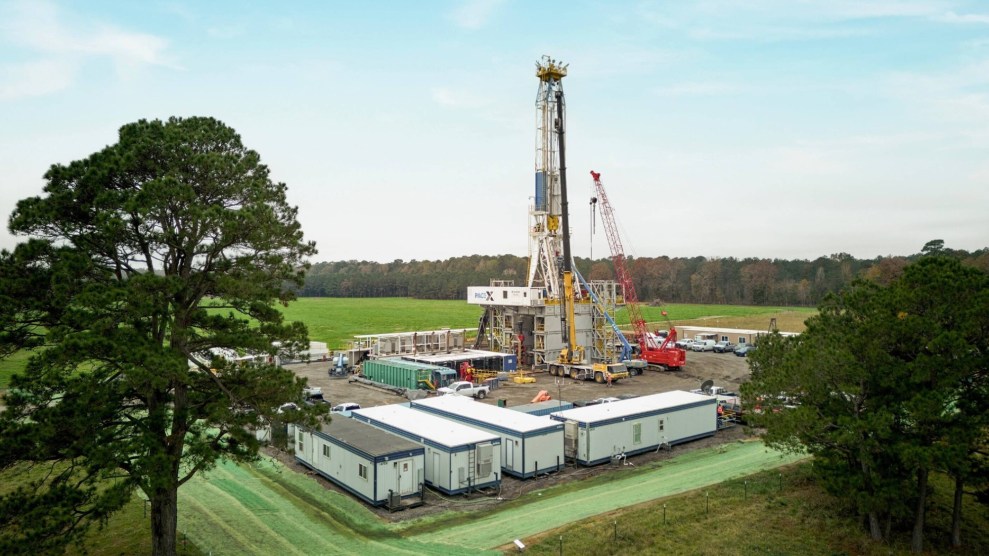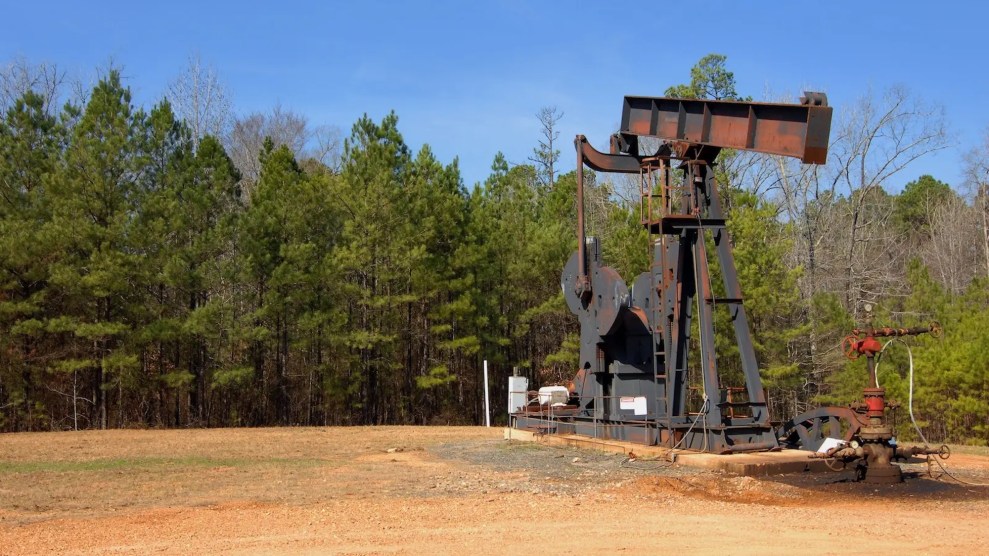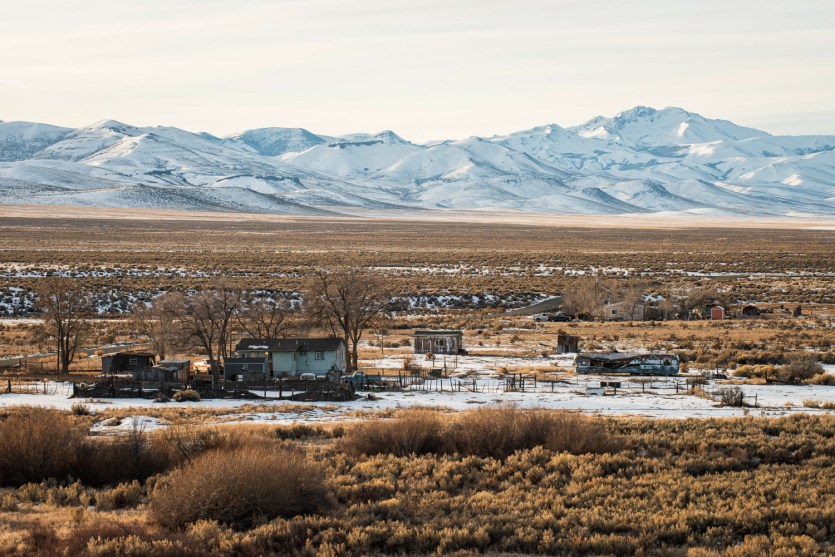
ExxonMobil’s first lithium rig.ExxonMobil
This story was originally published by Yale360 and is reproduced here as part of the Climate Desk collaboration.
The town of Smackover, Arkansas, was founded a hundred years ago when a sawmill operator got lucky: his wildcat oil well yielded a gusher. For a time in the 1920s, the oil field beneath the clay hills and swampy creeks in this stretch of southern Arkansas was the world’s most productive site. Now, boosters say the region will help usher the world into an oil-free future, thanks to the discovery of underground brines that are rich in lithium.
Lithium is one of the most important metals in the transition to renewable power. Lithium-ion batteries are, thanks to their lightweight and high energy density, currently the top choice for storing energy in electric vehicles, and a potential tool for grid storage, too. Global production of the metal tripled throughout the 2010s, and demand is projected to increase as much as 40-fold by mid-century.
But that presents several conundrums. Though geologists have already identified more than 100 million tons of lithium across the globe, easily enough to meet projected demand for decades, the world’s supply is currently blasted out of rocks—which are then roasted at temperatures as high as 2,000 degrees F—or extracted from brines in the high Andes, a process that lowers the water table in an already arid region and leaves behind toxic residues. Given the carbon emissions from hard-rock mining and the water stress induced by evaporative mining, a recent article in Nature, written by five researchers at Lawrence Berkeley National Lab and an industry consultant, warned that “simply ramping up lithium production at existing sites could negate the benefits of the clean technologies they power.”
One possible solution, the authors suggest, is direct lithium extraction, or DLE, in which lithium is pulled out of brine while leaving other dissolved compounds behind. That process could conceivably avoid the need for enormous amounts of energy or water. DLE, though still in its infancy, is being tested in dozens of sites across the world, from Chile to California, and is reportedly in use already at a few sites in China. A report from UCLA’s Luskin Center for Innovation, prepared for The Nature Conservancy, says, “DLE appears to offer the lowest impacts of available extraction technologies.”
Other experts say the Smackover site, which is uncommonly well-suited to DLE, may be its most significant proving ground. That’s because the region features plenty of fresh water, brine with high concentrations of lithium, and an existing array of wells, pipelines, and refineries from ongoing mineral production, thus reducing the amount of land that would be disturbed.
But questions remain about DLE’s impacts, which have not been closely studied in Arkansas. How much water will these projects consume? Some scientists have expressed concerns that DLE might be more water-intensive than its promoters suggest. And what happens with DLE’s wastes, which can include some of the same toxins left behind in evaporative ponds? Much of the lithium mining companies’ data is proprietary, hindering research efforts, and pollution from existing brine-extraction industries that target bromine has raised questions about Arkansas agencies’ oversight. There are few environmental advocacy groups in this rural region of the state, but national groups have expressed concerns about the many unknowns surrounding the technology.
The core idea of direct extraction is hardly new: many of the techniques now being tested at lithium mines were developed for use in desalination and wastewater treatment. Perhaps the simplest form of DLE, at least conceptually, is a selective membrane, which acts like a sieve that allows only lithium to pass through. Other approaches use physical “sorbents” — materials that are designed to selectively bond with lithium — or an ion exchange process. The brine can be reinjected into the ground after the lithium has been extracted, helping to reduce environmental impacts.
Already, such technologies have managed to recover as much as 95 percent of the lithium in experimental tests, a paper in Nature Reviews Earth & Environment noted last year. However, that accomplishment comes with a caveat: less than a third of published DLE experiments have been conducted on real-world brines. And because the concentration of brines — and the make-up of other compounds in the mix — vary widely, every site will require a tailored approach.
Compared to hard rock mining, DLE uses far less energy to produce the same amount of lithium. Compared to evaporative mining, the picture is more complicated. In the high Andes, brines are pumped into vast pools, and because water is evaporated using free heat provided by the sun, energy consumption is low. But pools can spread across thousands of acres, where heavy metals like arsenic and radioactive materials like uranium can be left behind, say research scientists in the field.
The US Department of Energy has supported research into DLE for more than a decade, though not in Arkansas. Instead, federal scientists have focused mostly on California’s Salton Sea, where an active geothermal field could provide low-carbon power to the DLE process. The Energy Department’s interest is partially a matter of geopolitics: China has cornered the market on lithium refining, has already produced 70 percent of the world’s lithium batteries, and Chinese companies are moving to acquire mines across the world. To encourage domestic production, the 2022 Inflation Reduction Act offers a tax credit for electric vehicles whose “critical minerals,” including lithium, are mined and refined in the United States or its trade partners.
But the geology of the Salton Sea presents major technical challenges. The brines are hot, saline, and slightly acidic, and it’s difficult to find an extractive technology that can withstand those conditions. The DLE technology would be added to existing geothermal power plants that already use 50,000 gallons of brine every minute—“like drinking out of a firehose,” says Michael McKibben, a geochemist at the University of California, Riverside— so the technology must be able to extract lithium very quickly.
Conditions appear more amenable in Arkansas, which sits at the heart of the “Smackover Formation,” a brine-rich expanse of limestone that stretches in a thin crescent from Texas to Florida and is named for the old oil-boom town that sits near its center. The formation contains less lithium overall than the Salton Sea, but its brines aren’t as hot and acidic, and they contain much higher concentrations of the mineral. In October, the Canadian firm Standard Lithium announced that a well in the Texas portion of the formation had yielded the highest concentration of lithium yet recorded in a North American brine.
Another advantage of working in Arkansas is its pre-existing infrastructure. In the 1950s, geologists found that the region’s brine contained high levels of bromine, which is used as a flame retardant. A brine-processing industry soon developed and remains a significant local industry. Now, some companies are planning to use those same facilities to produce lithium. That’s a win for industry, as it lowers capital costs, but also for the environment, The Nature Conservancy noted in a 2022 report on lithium extraction, because no new land has to be cleared.
This is an ideal scenario for lithium production since it reduces impacts on local ecosystems, says Douglas Zollner, director of science and strategy for The Nature Conservancy’s Arkansas field office. He cautions, though, that as the industry grows, it could move beyond such “brownfield” sites into new “greenfield” facilities.
Currently, a large share of proposed U.S. DLE projects are in Arkansas: Standard Lithium, backed by Koch Industries, has been running a demonstration DLE project in Arkansas since 2020, while lithium giant Albemarle is investigating whether DLE technology can be added to its Arkansas bromine facilities. In May, ExxonMobil purchased the mineral rights to 120,000 acres in Arkansas and in December dug its first lithium well. The company has said it will use conventional oil and gas drilling methods to draw brine from reservoirs some 10,000 feet underground and then use DLE to separate lithium from saltwater. Exxon announced a 2027 target date for commercial production and claims it will produce enough lithium by 2030 to power a million electric vehicles. It’s now shopping for a DLE technology to license.
ExxonMobil’s presence is particularly important, given the volatility of the lithium market, says Shon Hiatt, director of the Business of Energy Transition Initiative at the University of Southern California’s Marshall School of Business. The price of the metal fell 80 percent last year, following a drop in demand for EVs in China, leading to layoffs at production facilities across the world. ExxonMobil, though, is well positioned to weather the downturn. “The price can be super low in 2024 and they don’t care,” Hiatt says. “They’re going to create a scale so that when the price comes up, it’s going to be profitable in another year or two.” The scale of investment in the region, he says, makes Arkansas a critical test case for DLE.
But, questions remain about the oversight of these Arkansas projects. While federal permits will be required before companies drill reinjection wells, so long as projects are not on federal land and do not receive federal funding, they will not be subject to the extensive reviews required by the National Environmental Policy Act. The Arkansas Division of Environmental Quality, one of several state agencies that will grant permits, has been criticized for its sometimes-lax policies. (The ADEQ did not respond to a request for comment.)
Despite the excitement over the potential of DLE, there are still questions that scientists need to address, says Alexandre Chagnes, a lithium mining expert at the Université de Lorraine in France, who co-authored the 2023 paper in Nature Reviews Earth & Environment. Brines sometimes need to be “pre-processed” before direct extraction begins, adjusting their heat or acidity. There are post-processing steps after extraction, too. Data on the energy costs of these steps are “scarce or not available,” the study said. In traditional lithium mining, of both hard rock and brines, pre- and post-processing accounts for the vast majority of carbon emissions, so the missing data makes comparisons difficult.
James Blair, a geographer at California State Polytechnic University who studies the lithium mining industry, notes that despite industry claims, DLE’s water usage remains a major unanswered question. “Depending on the circumstance of the operation, it may even be more exhausting and depleting of water resources” than other types of lithium mining, he says. In the ion-exchange process, for example, fresh water is needed to rinse sorbents from the lithium.
Chagnes and his co-authors analyzed 57 recent reports on water-dependent DLE technologies and found that a quarter indicated freshwater use at rates 10 times higher than the Andean evaporative facilities used as a reference. Another quarter lacked data entirely. While Chagnes is hopeful that the technology will indeed reduce water use, since much information comes from the industry itself, “it is always difficult to know exactly the truth,” he says.
One plant at Salar del Hombre Muerto, in Argentina, has long employed DLE in a hybrid, two-step process that also includes partial evaporation. Data from the plant’s operator, Livent, suggests the plant consumes more fresh water than other local lithium mines that use evaporative ponds alone.
On the Salton Sea, a community group, Comite Civico del Valle, has threatened to sue to stop construction of a lithium plant in part because of concerns over water use in an area already experiencing a megadrought. The group estimates that proposed DLE projects in the region would consume more freshwater than some evaporative mining in the high Andes. The brines could contain arsenic, lead, cadmium, and other harmful metals that would not be reinjected, the group says, noting that more clarity about waste disposal is necessary.
Water is plentiful in Arkansas, at least for now (scientists expect climate change will make droughts in the state more severe), and companies are making some efforts to reduce water consumption. Albemarle is piloting the use of membrane-based technologies, which Chagnes says will use less water. But, studies suggest that the Smackover Formation is connected with the freshwater aquifer that lies closer to the surface, a kind of connectivity that The Nature Conservancy, in its 2022 report, suggested should be analyzed.
Daniel Larsen, a hydrogeologist at the University of Memphis, noted that in a properly designed system, damaging impacts on surrounding waters would be unlikely. But he said errors in construction or operation, as well as natural disasters, “could release fluids at the surface and damage water quality in wetlands, streams and lakes.”
Still, The Nature Conservancy—the one environmental group that has publicly commented on the Smackover developments—is cautiously supportive. The world needs to make a transition toward renewable power “with eyes wide open,” says Zollner. Developing a low-carbon economy “will take an incredible amount of infrastructure development, and we must minimize the environmental impact without halting the move into a low-carbon future.”














